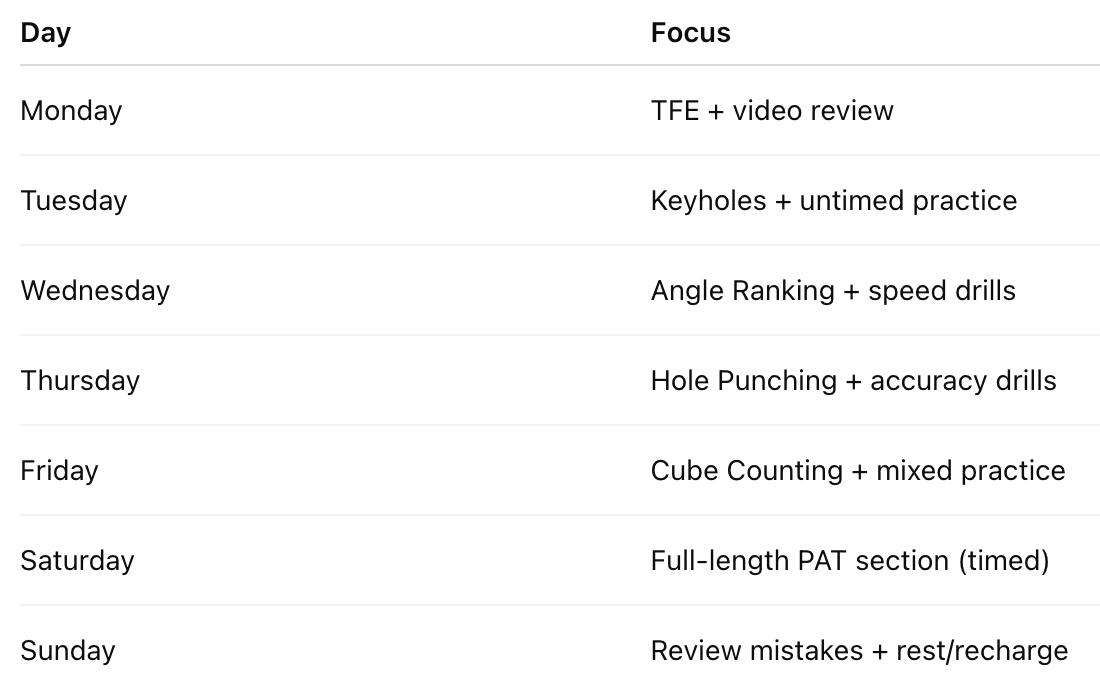Top 10 Strategies to Improve Your PAT Score on the DAT
Crush the Perceptual Ability Test with Smart, Proven Techniques
Struggling with the PAT section of the DAT? Discover 10 proven strategies to improve your PAT score and boost your chances of getting into dental school.
If you’re preparing for the Dental Admission Test (DAT), you already know the Perceptual Ability Test (PAT) is unlike anything you've studied before. It doesn’t test content—it tests how well you can visualize, manipulate, and analyze 2D and 3D objects in your mind.
For many pre-dental students, the PAT is one of the most intimidating parts of the DAT. But here's the good news: your PAT score can dramatically improve with the right strategy, consistent practice, and a clear game plan.
In this post, you’ll learn the top 10 expert-backed strategies to raise your PAT score and stand out to dental schools.
1. 🧠 Understand the Six PAT Sections Inside and Out
Before you can improve, you need to know exactly what you’re facing:
Keyholes (Apertures)
Top-Front-End (TFE)
Angle Ranking
Hole Punching
Cube Counting
Pattern Folding
Take time to understand what each section tests and what your current strengths and weaknesses are. A diagnostic PAT test is a great place to start.
2. 📊 Track Your Progress by PAT Subsection
Don’t just focus on your overall PAT score—break it down by subtest. That way, you can:
Target your weakest areas (like TFE or Pattern Folding)
Double down on high-yield sections (like Hole Punching)
Balance your study time more efficiently
Tools like DATBooster, DAT Bootcamp, and PATCrusher let you analyze your performance by question type.
3. ⏱️ Train for Accuracy First, Then Speed
Rushing through practice problems too early is one of the biggest mistakes you can make. Start with untimed practice to build a strong foundation.
Once you’re consistently accurate, gradually introduce time pressure. The goal is to become accurate and fast by test day.
4. 🧩 Use Spatial Visualization Drills Daily
The PAT is a skill-based test. Think of it like a sport—daily drills improve your “visual-spatial muscle.” Try:
Folding paper and punching holes (for Hole Punching)
Practicing origami or puzzle games (for Pattern Folding)
Drawing top, front, and end views of objects (for TFE)
Even 15–30 minutes a day of focused spatial training can make a huge difference.
5. 🛠️ Use the Best PAT Tools and Resources
Not all study tools are created equal. For PAT prep, we recommend:
DATBooster PAT Generator – highly realistic and widely used by high scorers
Bootcamp’s PAT Academy – detailed video strategies for each section
PATCrusher – known for analytics and question customization
Angle Ranking and Cube Counting mobile apps – perfect for quick drills on the go
6. 🧭 Learn the "Line of Sight" Strategy for TFE
The TFE section confuses a lot of students. One high-yield approach is the “line of sight” method, where you imagine looking at the object from the specified viewpoints (top, front, end).
Pair this with drawing practice to reinforce 3D understanding.
7. 📐 Master Hole Punching with the Symmetry Trick
Hole Punching is highly predictable. Use the fold symmetry trick:
Mentally divide the paper into quadrants
Count how many folds occurred
Reflect the hole across each axis in reverse
With practice, this section can become your fastest and most accurate.
8. 🎯 Use Elimination Tactics on Pattern Folding and Keyholes
When stuck, don’t guess blindly. Eliminate answer choices based on:
Misaligned edges
Incorrect shapes
Impossible folds
You’ll often narrow it down to 2–3 choices quickly, which increases your odds of selecting the right one—even if you're unsure.
9. 📝 Review Mistakes Immediately After Practice
Don’t just do PAT questions—analyze your mistakes. Ask yourself:
Was it a careless error or a misunderstanding?
What would I do differently next time?
Can I spot a pattern in my mistakes?
Write down challenging problems and revisit them weekly. This kind of reflective practice is what separates 20+ scorers from the rest.
10. 📅 Stick to a PAT-Focused Study Schedule
If you don’t plan PAT study time, it’s easy to neglect. Here’s a simple weekly model for beginners or re-takers:
Adjust based on your needs, but aim for consistent exposure 5–6 days a week.
🎓 Final Thoughts: PAT Mastery Takes Time—Start Now
Improving your PAT score is 100% possible. In fact, many students jump 3–5 points or more with focused effort and strategic practice. Like any skill, it gets easier the more you train.
Need Help Getting Started?
At Dental School Declassified, our PAT experts are licensed dentists who scored in the top 1% on the DAT. We offer:
1-on-1 PAT tutoring
Study plan customization
Group coaching for strategy and confidence
